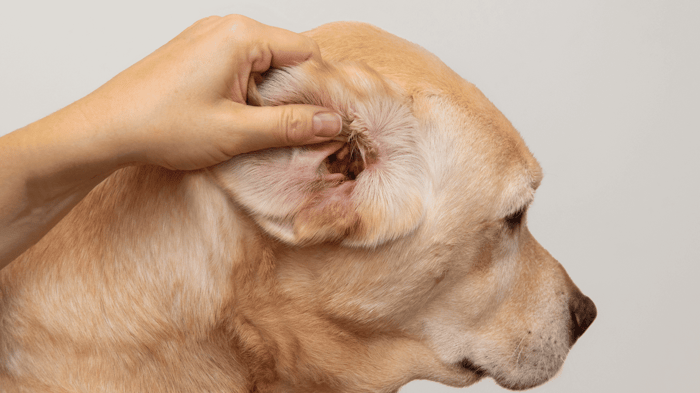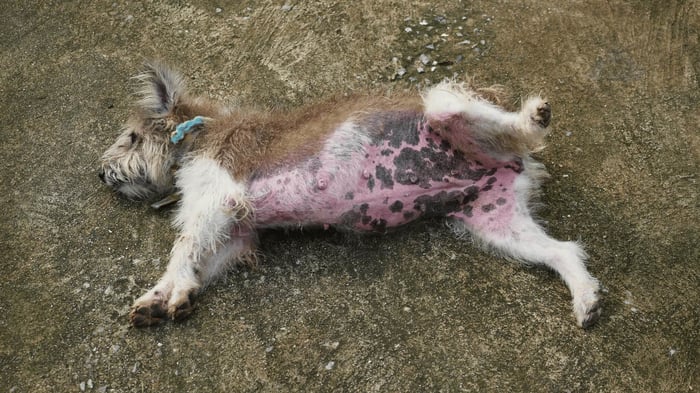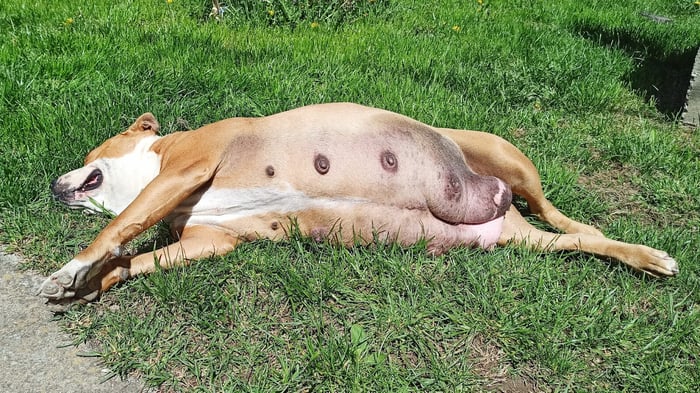Noticing that your dog’s ears smell bad is more than just an inconvenience, it’s usually a sign of infection. But did you know different smells mean different things? You may catch a whiff of must, fish, vinegar, or even something rotten. So, what do all these different odors from your dog’s ears?
Naturally, one of the most common causes of stinking dog ears is ear infections. Bacteria, yeast, or parasites can cause ear infections and may result in a foul odor, discharge, and discomfort for the dog. Other causes of canine ears that smell bad may include allergies, foreign objects in the ear, or excessive wax buildup.
Canine ear cleaning is a regular part of doggy maintenance and health. But even so you may still need veterinary care if they notice unusual smells or symptoms. With proper care and attention, dog ears can be effectively managed and prevented. So, we’ve consulted the work of canine ear health experts sources, such Dr. Bajwa, DVM Here is all you need to know about dog ear infections and odors, from causes to treatment to a healthy pup.
So, Why Would A Dog Ear Be Smelly?
Bacteria or yeast ear infections, called otitis, are the most common cause of smelly dog ears. Other causes of a foul odor include ear tumors, polyps and growth, ear mites or a foreign body stuck in the ear. Moisture trapped in the ears, allergies, and underlying metabolic disorders can also be at the roon of the issue.
Dogs with floppy ears, like Cocker Spaniels and Basset Hounds, are more prone to ear infections because their ears trap moisture and provide a warm, dark environment for bacteria and yeast to grow.
Poor hygiene, like infrequent ear cleaning, can lead to smelly dog ears. However, it’s also common in dogs with allergies and sensitive skin. And it’s important to pay attention to these odors as they can indicate an underlying issue that needs attention.
If you notice a foul odor coming from your dog’s ears or any other signs of ear problems, it’s essential to consult with a veterinarian. They can properly diagnose the issue and recommend appropriate treatment, including cleaning the ears, medication, and addressing any underlying causes.
Regular ear maintenance, such as proper grooming, can also help prevent ear problems in dogs. In some cases, surgery may be necessary to remove foreign objects or correct structural abnormalities in the ear canal.
Understanding Dog Ear Anatomy
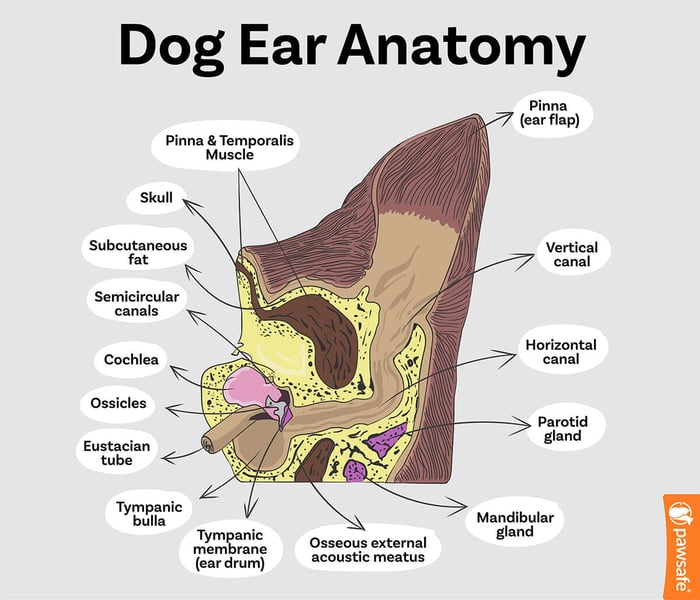
To properly care for a dog’s ears, it’s essential to understand their anatomy. A dog’s ear comprises three parts: the outer ear, middle ear, and inner ear.
The outer ear, also known as the pinna, is the visible part of the ear on the side of the dog’s head. It comprises skin, cartilage, and muscles and helps funnel sound into the ear canal. If scabs keep reoccurring on your dog’s pinna or ear flap , please notify your vet, as this may be a sign of dog ear edge dermatitis.
The middle ear is just behind the eardrum and contains three tiny bones that transmit sound vibrations to the inner ear.
The inner ear translates sound vibrations into nerve impulses that the brain can interpret. It also helps with balance and orientation.
Now when it comes to smells, discharge, and infection in the ear, there are three basic types, depending on where in the ear canal the infection is. Most infections are in the outer ear canal, and this is called otitis externa. When it is in the middle ear, it is otitis media, and when it is in the inner ear, it is otitis interna.
Middle and inner ear infections have much worse symptoms than outer ear infections. While outer ear infections, otitis externa, can be painful, uncomfortable, and itchy, if the infection gets deeper into the ear, you will start to see things like falling, stumbling, or darting eyes.
It’s important to note that a dog’s ear canal is longer and more L-shaped than a human’s ear canal. This makes it easy to get infected and problematic to clean it well. It’s also important to avoid inserting anything into the ear canal, as this can damage the delicate structures.
What Different Dog Ear Odors Might Mean
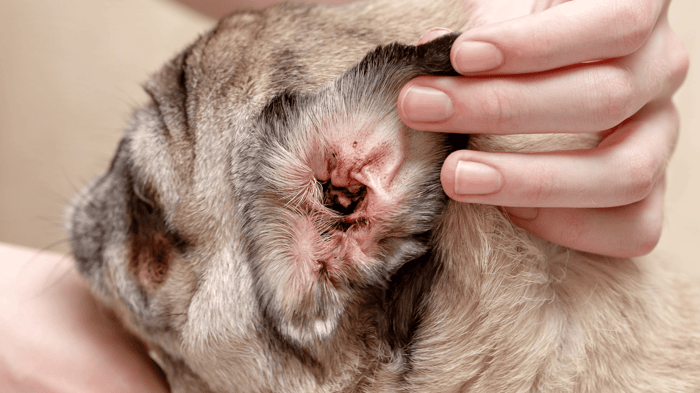
Identifying the type of smell coming from a dog’s ear can help to determine the cause and the appropriate treatment. Here are some common dog ear smells and what they might mean.
1. Musty, Cheese, or Cheetos Smells
A strong musty scent in your dog’s ears is a classic sign of Malassezia otitis. This can also smell very moldy, cheesy or like cheetos. Sometimes this is also a sweet smell. Malassezia pachydermatisis a common strain of fungus or yeast that infects a dog’s skin (causing dermatitis rashes) and ears. In fact, it’s responsible for about 95% of dog yeast ear infections. Canines with a lot of oily ear secretions or narrow ear canals are very at risk.
Yeast overgrowth can occur for various reasons, including allergies, moisture, and poor hygiene. Other symptoms of yeast infections include:
- Redness;
- Itching;
- Head tilting;
- Blood blisters, sores and swelling in the ear flap;
- Thickening or discolored skin; and
- Discharge.
Treatment often involves cleaning the ear with a veterinarian-recommended solution and administering topical antifungal medication.
2. Fish or Vinegar
Fish and vinegar may indicate a smell of something fermenting. This usually means fungal ear infections, like Malassezia otitis, as the yeast may be producing a stinky by-product that could smell a bit fishy or sour.. However these fish or vinegar are not common scents you’ll get in an ear infection, so it may also be bacterial infection.
A fishy smell from dog’s usually means they have an anal sac impaction, so if you smell fish from their ears, make sure the scent is not really coming from the whole dog. Sometimes it also has to do with their bladder or kidneys. However, if the fish scent is definitely coming from the ear canal, then it is definitely an infection.
3. Poop or Rotting Flesh
A dog’s ear smelling like poop can indicate a bacterial infection. The odor is caused by bacteria that break down organic matter, producing a foul smell. One specific type of bacterial ear infection is Pseudomonas aeruginosa. This is not common in otitis, but it does come from rotting matter. So it’s a possible culprit.
What may have happened is that a normal itchy ear infection caused your dog to scratch their ears and break open skin. Broken skin can quickly turn into a hot spot, also called acute moist dermatitis or pyotraumatic dermatitis. This will be an open or crusty ulcer that smells like rotting meat or something dead.
Another possibility is growth in the ears. This will also lead to a terrible stink, with pus and other discharge, so make sure you get to a vet quick if this is what you smell.
Other symptoms of bacterial infection include discharge, redness, and swelling. Treatment typically involves cleaning the ear and administering antibiotics.
4. Old Trash or Garbage
If a dog’s ear stinks of garbage or old trash (bad but not rancid), you may be dealing with ear mites, especially if you notice dark debris in the ear that looks like coffee grounds. Ear mites are tiny parasites in the ear canal, causing irritation and inflammation.
Other symptoms of ear mites include itching, shaking of the head, and dark and waxy discharge. Treatment involves cleaning the ear with a veterinarian-recommended solution and administering medication like fluralaner to kill the mites.
5. Dogs Ear Smells Like Fritos Or Corn Chips
If a dog’s ear smells like Fritos or corn chips, it may be due to a buildup of yeast or bacteria. This odor is commonly referred to as “Frito feet” and more commonly comes from bacteria called Pseudomonas or proteus that can affect a dog’s paws. However, research shows these bacteria can also affect a dog’s ears, although rarely. But when it does, it is very difficult to treat.
Other yeast or bacterial infection symptoms include redness, itching, and discharge. Treatment involves using medicated cleanser and administering oral antibiotics and anti-inflammatory medication.
9 Causes of Stinking Ears In Dogs
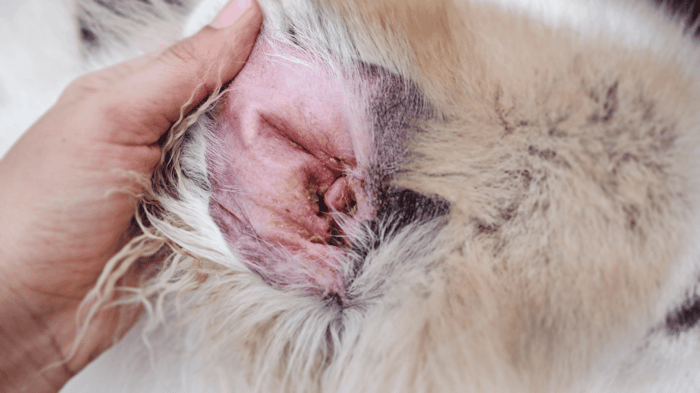
Studies show that ear infections affect 10-20% of dogs and are among the most common health issues. They can lead to unpleasant smells emanating from the ears but they are not the only cause of odor. They can also be signs of underlying health conditions that are affecting the microbiome in your dog’s ears and causing a chronic overgrowth of bacteria or fungi.
1. Yeast Infections
Also known as Malassezia dermatitis”, yeast infections are a common cause of smelly dog ears. They occur primarily in dogs with long, floppy ears due to trapped moisture. According to studies, too much yeast can also lead to yeast infection in your dog’s ear when your dog’s body works overtime to get rid of the extra yeast.
When it comes to yeast infections, we usually think of Candida, the yeast that causes thrush in humans. But studies show this strain is rare in dogs (only about 5%).
Yeast infection can occur in your dogs’ ears, paws, and skin folds. Symptoms of yeast infections include
- Itching;
- Redness;
- Discharge;
- Musty odor;
- Head tilt;
- Head shaking;
- Sores on the skin; and
- Hair loss.
2. Bacterial Infections
Bacterial infections are another common cause of smelly dog ears, with the most common types of bacteria being the common Staph, Escherichia coli, and Klebsiella spp. They result in external ear canal swelling. Also known as Otitis Externa, it can be acute or chronic. It occurs when bacteria enter the ear canal and grow and multiply. Primary factors that lead to acute Otitis Externa include:
- Parasites;
- Foreign bodies;
- Glandular disorders;
- Allergies; and
- Fungal.
If untreated, acute Otitis Externa causes severe chronic Otitis Externa, which could be more challenging to treat. It can also travel into the middle and inner causing more complications, hearing loss and even neurological issues. Causes of chronic ear infection include:
- Bacteria;
- Yeast;
- Medication reaction; and
- Overcleaning.
The best treatment for chronic Otitis Externa is prevention. Dog owners should be shown how to clean their dogs’ ears properly. The frequency of cleaning decreases from daily to twice every week to avoid overcleaning.
3. Ear Mites (Otodectes)
Ear mites are tiny parasites that can reside in a dog’s ear canal, causing irritation and infection. Symptoms of ear mites include scratching, head shaking, and a strong odor.
In a particular study on fluralaner (sold as Bravecto), twenty-four dogs and sixteen cats were experimentally infected with ear mites; the drug killed 99.8% of ear mites in dogs. So simple parasite treatments are pretty effective if ear mites are causing stinky ears.
The vet can help with special ear drops or meds to get rid of the mites. Cleaning those ears out is a must-do too.
4. Scabies Mites (Sarcoptes) & Demodicosis Mites (Demodex)
If a dog has scabies, you may notice on-stop scratching, hair loss, and crusty ear skin. Usually, Medications from the vet can zap those mites. Sometimes, treating the whole body is needed.
For Demodex, you may see hair loss, redness, and skin sores, either in one spot or all over. Treatment varies, but it often involves meds, skin TLC, and fixing any other health issues.
5. Ear Growths, Polyps, or Tumors
When your dog has any kind of growth in their ears, you need to watch for a foul smell, head tilting, or balance problems. You might even spot weird lumps.
If ear tumors are the problem, then surgery is usually the way to go. Sometimes, biopsies are needed to figure out what’s going on.
6. Foreign Objects
If something foreign like grass seeds gets stuck in the ear, it can cause infection and a bad smell. Your vet will need to examine the ears and carefully remove the foreign object and treat any infections.
7. Allergies & Dermatitis
Allergies are commonly blamed for ear infections. But have your dog fully tested for other causes if the stink and infection in the ears is a chronic issue. Often food allergies are blamed when the problem is really a metabolic or immune disorder. Allergies could be caused by something in your dog’s food, pollen, dust mites, fleas or something else in the environment.
Fixing allergies in dogs that affect their ears and cause a sink means tackling the root cause. This might mean changing your pup’s diet, allergy tests, and using meds.
8. Metabolic Disorders
Conditions like hypothyroidism and Cushing’s Disease can mess with your pup’s skin and coat, causing ear funk. In fact, if you have a middle-aged or senior dog whose ears always smell and who always seems to struggle with infections, it’s important to have them tested for underlying conditions. For example, Cushing’ disease forces the body to release a lot of cortisol that suppresses the dog’s immune system, and this can let bacteria and fungi infect the ears.
Medication and lifestyle changes can help manage these disorders and get rid of the stinky ear problem.
9. Immune Disorders
Sometimes, immune disorders conditions like pemphigus or lupus can cause ear and skin issues. These autoimmune problems often look exactly like allergies, so make sure to screen your dog for these issues if their ears smell bad.
If the problem is an autoimmune disease, the vet will use meds, maybe even immune system-suppressing ones, to keep things in check.
Remember, if your dog’s ears smell funky, or they’re showing any strange ear behavior, it’s time for a vet visit. Catching problems early and getting the right treatment can make sure your four-legged buddy stays happy and odor-free!
Symptoms Accompanying Smelly Dog Ears
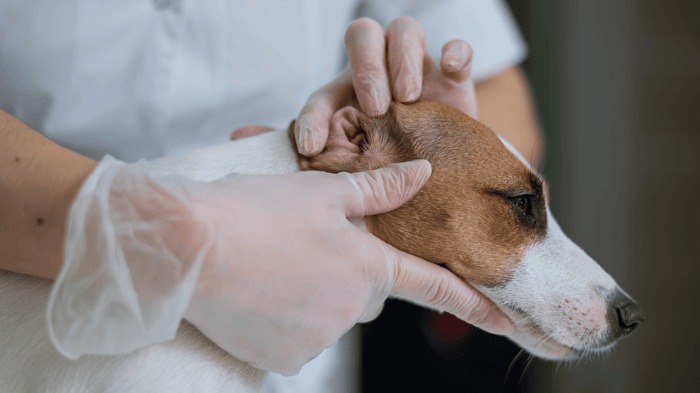
When a dog’s ears emit an unpleasant odor, it is a sign of an underlying problem. In addition to a foul smell, other symptoms may indicate an issue with the dog’s ears. In this section, we will discuss the most common symptoms that accompany smelly dog ears.
Excessive Scratching
Dogs with smelly ears are likely to scratch their ears excessively, which can be pretty uncomfortable. Excessive scratching can lead to further irritation and even infection. If you notice your dog scratching their ears frequently, it is vital to take them to the vet for an examination.
Redness and Swelling
Another symptom that may accompany smelly dog ears is redness and swelling. This is often a sign of inflammation, which various factors, including allergies and infections, can cause. If your dog’s ears appear red and swollen, seeking veterinary care as soon as possible is essential.
Ear Discharge
If your dog’s ears emit a foul odor, they may also produce an abnormal discharge. This discharge can range in color from clear to yellow or even green and can be a sign of infection. In addition to the smell, the discharge may cause the fur around the ears to become matted or sticky, inviting houseflies.
If you notice any discharge coming from your dog’s ears, it is crucial to have them examined by a veterinarian. Some nasty parasites like mango worms that lay their larva in a dog’s skin, are drawn by the smell of organic infection, so it’s vital to take care of these issues quickly before you have to deal with more complications.
Head Tilting to the Ear with Infection
This is one of the early signs of ear infection. Your dog will tilt their head to one side to relieve the pressure and deal with the itch in their ears.
Head Shaking
Dogs with pain, itching, or discomfort in their ears will likely shake their heads a lot.
Rubbing Ears
Ear infections cause significant discomfort to our dogs. Dogs will try to rub the infected ear to tolerate the pain. When the condition gets too extreme, you may see signs like a dog losing balance, hearing loss, and walking in circles.
Bleeding Ears
This excessive shaking can cause the blood vessels to break, leading to bleeding.
Preventing Smelly Dog Ears
Regular Cleaning
Avoid too much ear cleaning as it alters the local ear canal and creates a risk for the development of otitis externa.
Proper Diet
It is also vital to increase omega fatty acids in the diets. Omega-3s lower inflammation and help the skin create a lipid barrier to protect it from infection better.
Regular Vet Checkups & Medical Screening
Treatments for Smelly Dog Ears
The first step in treating ear infections is finding the possible cause. Your dog’s body tries to get rid of these toxins as best as it can. There are several treatments available for smelly dog ears. The appropriate treatment for a particular dog will depend on the underlying cause of the smell. Sometimes, a combination of treatments may be necessary to resolve the issue entirely.
Medicated Ear Drops
Medicated ear drops are a standard treatment for smelly dog ears. These drops typically contain an antifungal or antibacterial agent to help eliminate the odor-causing bacteria or fungi. Some ear drops may also include a steroid to help reduce inflammation and itching in the ear.
When using ear drops, it is important to follow the instructions carefully. The slides should be administered directly into the ear canal, and the ear should be massaged gently until you hear a squishy sound. This should be done twice a day for 5 to 10 days.
Sometimes, the drops may need to be administered for several weeks to eliminate the smell.
Antibiotics
If a bacterial infection causes smelly ears, antibiotics may be necessary. Antibiotics can be administered orally or topically, depending on the severity of the condition.
Sometimes, a combination of oral and topical antibiotics may be necessary. If dog owners cannot clean their dogs’ ears at home, more severe ear irrigation in the hospital using sterile saline is warranted. This flushing should be done under anesthesia.
Surgery
Surgery may be necessary in rare cases to resolve chronic ear infections causing a foul odor. Surgery may involve removing the diseased tissue or correcting an underlying structural issue in the ear.
Surgery is typically reserved for cases where other treatments have failed to resolve the issue. Discussing the risks and benefits of surgery with a veterinarian before proceeding is important.
Frequently Asked Questions (FAQs)
What causes a dog’s ears to smell bad?
Dog Ears Smells Like Rotting Flesh Or Dead Animal
How can I clean my dog’s ears to prevent bad smells?
What are some signs of a dog ear infection?
Can a dog’s ear smell like fish or skunk?
How do I treat my dog’s yeast infection in their ears?
What are some effective dog ear-cleaning solutions?1
Final Thoughts
Dog ears can signify various issues, ranging from mild to severe. Regular cleaning and maintenance can help prevent ear infections, but it is also important to use the right products and techniques as a veterinarian advises.
Remember that every dog is unique and may have different needs when it comes to ear care. If you suspect that your dog has an ear infection or other health issue, do not hesitate. Delayed treatment can lead to more severe problems and discomfort for your pet. You can help keep your dog’s ears healthy and free from unpleasant smells with proper care and attention.


